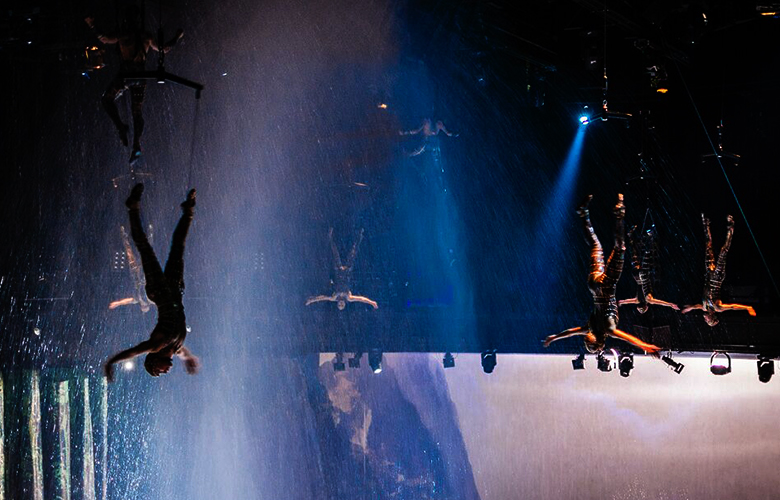
A Rigger’s Guide Part 2 – Rescue Plans to Rehearsals: Where we finalize our concepts, cover all our bases and begin to build segments of a production.
So, this is gonna sound obvious, but before any action takes place, we need to determine what the rescue plan is in the case control is lost or the performer/technician is incapacitated. This is not just for climbing and flight scenarios, but also for any instance where someone might be in some weird position that would not allow for the average medic to make it to their location like a confined space. It might be as simple as knowing where a ladder is or as convoluted as having several competent people accessing a location and performing a complex rescue that has been ideally rehearsed and validated as effective in said scenario that all necessary artistic and technical staff are comfortable with.
Additionally, in any rescue scenario, it needs to be made clear from the beginning of the R&D phase who is responsible for coordinating said rescue. This might change depending on the circumstances. For example, a Rescue Lead from the Rigging Department might coordinate until the individuals are landed and then hand responsibility over to the onsite medical staff. Alternatively, you may be in a house where Stage Management or the Lead Deck Carpenter is in charge of overseeing rescue operations. Ultimately, it must be someone who is aware of the space and resources, knows the procedures, is level headed and gives clear and concise commands. This is something that should be determined and maintained consistently so as to avoid confusion in an already stressful situation. Hopefully, you’ll never need any of these things, but best to be prepared.
Obviously there are standard acrobatic devices that are easy to come by; silks, lyra, straps, we’ve all seen these things. But at some point, if you’re lucky, the designers and choreographers are gonna hit you with a new and exciting act that no one has ever built before [Yay! Fan-girl time!!]. So what do you do? You’re probably in a situation where you can’t exactly just pop by the local aerial yoga store and pick something up.
Reading copious technical documents and being familiar with gear from all sorts of industries comes in handy. There is a true art, I believe, in finding ways to beautifully and effectively mesh rated materials that, in a normal world, would never see each other and ask them to play nicely. Yes, some old-fashioned engineering and math skills are gonna pop up, but as an experienced rigger you’ve already done these things before. Just need to be clear on what industry standards you are working with so that your safety factors work. All of these things will likely be on an individualized basis. These should have live/active documents available to be quickly referenced and available for any amendments.
The top of every day starts with inspections. We have to ensure that the equipment being used to fly people across the stage is in fact capable of doing just that. This involves everything a performer touches. Harnesses, handloops, SRDs, aerial apparatus, connectors and rope (metal or synthetic). Each item will have different points of inspection that a manufacturer will stipulate as approved or not approved wear & tear.
It is crucial to identify immediately any piece of equipment that might be damaged and have it removed from service and replaced. It is not very common these days to find equipment in a fully damaged state, primarily because regular inspections are a thing. Minor wear may be noted and monitored and eventually reach a point where the competent inspector has determined the item ought to be removed from service long before it becomes a hazard.
Items that are known to experience wear more frequently are inspected more often to ensure that defects are identified sooner. Whilst these inspections are excessively repetitive, I find them to be a relaxing routine that gets me into the mindset of the tasks I will be performing, remembering that myself and my friends are using this gear and anything less than 100% diligence can drastically affect our lives.
Any time a new apparatus, person, cue is being added to a show, then a litany of rehearsals have to be gone through to ensure that the cast and crew can effectively and safely execute the act on a continuous basis. We are constantly assessing these sequences and providing feedback to performers, automation and stage management on whatever might need amendment.
We have a unique overhead perspective and can often predict issues before they occur and it’s at this stage that we are not only testing the effectiveness of the equipment, but we are also getting feedback from the stunt person on the flight itself. How comfortable was the take off and landing? Do we need to adjust the harness to move the center of gravity and make a certain motion easier on the performer?
This is where the trust and open communication with performers comes into play big time because they are the ones who ultimately are performing the stunt and can give us the best information on how to improve their experience/look. It is likely during creation sessions that they will be sat in these harnesses for ongoing periods, taking appropriate breaks as needed. For this reason, making little adjustments here and there not only provides for greater comfort, but also can help us in the prevention of suspension trauma along with proper training.
So ideally at this point in the game, y’all have made some acts, merged them together with some ongoing theme, and decided that this is legit what you want to do. In the final segment we wrap up validations and into shows.
Show Creation: A Rigger’s Guide – Part 1
Acrobatic Rigger: Explaining My Career


Growing up in art schools, Anna is a vocalist turned technician, who spent half her career building scenery before merging into various fields of automation, stage management, wardrobe, and now rigging among others. She enjoys being on the move, sharing knowledge, acting like a dork, never settling for sub standards and being a global citizen. Now as an adult student, Anna believes that everyone is a teacher whether they know it or not, that random conversations happen for a reason and that the universe can guide those who search with intention.
Read Full Profile© 2021 TheatreArtLife. All rights reserved.

Thank you so much for reading, but you have now reached your free article limit for this month.
Our contributors are currently writing more articles for you to enjoy.
To keep reading, all you have to do is become a subscriber and then you can read unlimited articles anytime.
Your investment will help us continue to ignite connections across the globe in live entertainment and build this community for industry professionals.